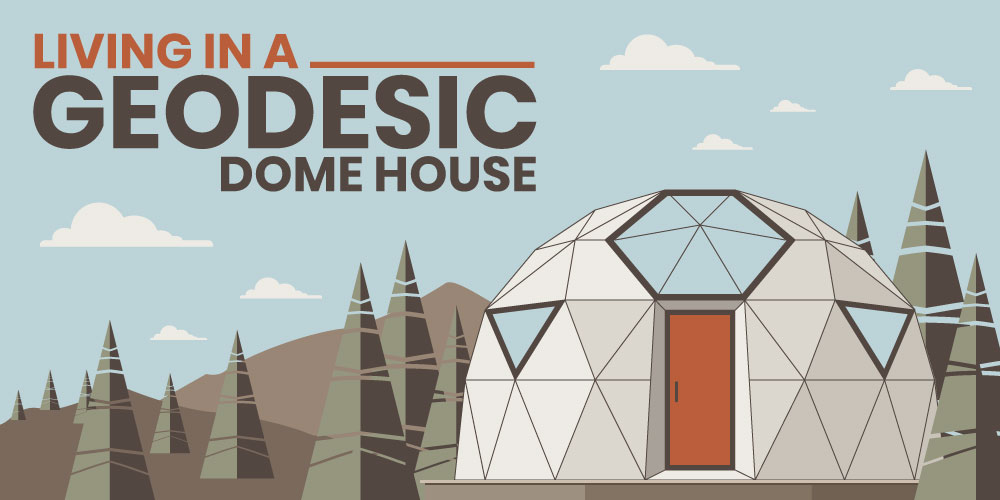
NAVIGATION
Geodesic dome houses are a bit nostalgic for me — an interesting story in optimism around a man named Buckminster Fuller. As of late, they’re having a bit of a resurgence as people are falling in love with these curious structures all over again.
Geodesic dome homes are spherical-shaped houses built from struts set on large circles with walls that curve around the base, and they have many uses.
Some people live in dome homes full time to be more connected to the earth and involved in an eco-friendlier life. Others have them in their yards as ADUs that they repurpose as personal art studios, greenhouses, guest homes, or Airbnbs. The possibilities are endless.

Hi, I’m Ryan
I’m all about living a life apart from the status quo and making your own way. While I love the life I’ve created in my own tiny house, I have definitely considered what it would be like to live my life in a geodesic dome!

What Is A Geodesic Dome House?

It may seem a little eclectic to build a dome house, but there are actually many reasons people gravitate towards this house shape and, oftentimes, end up falling in love with it.
What’s intriguing about geodome houses is that they use a third less surface area to maintain the same amount of volume as a traditional home thanks to their unique shape. Geodome houses are also extremely durable, thanks to the strength of the connected triangles.
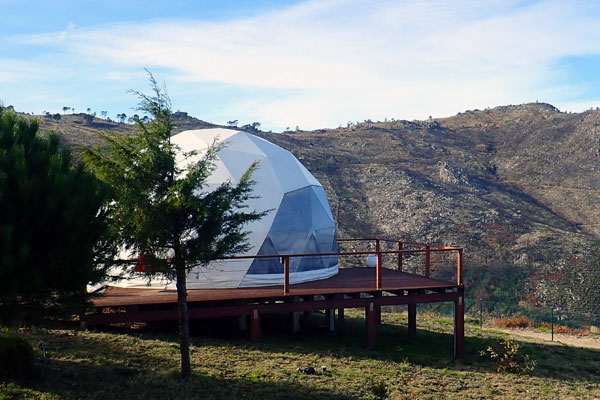
However, along with the advantages, there are some major drawbacks to the dome dwelling design that are worth taking into account before you break ground on your geodesic home.
PROS
- Low cost
- Energy efficient
- Durable
- Withstands storms
- Requires fewer building materials
CONS
- Creating rooms is challenging
- Hard to hang things on walls
- Sound echoes
- Prone to leaks
- Difficult to roof
Geodesic Dome Home Features

As with any house, there is a great deal of variability within the way each geodesic dome house is made and what features it includes.
Most geodesic domes are energy efficient and eco-friendly. They’re often built out of concrete over an air form, and tend to embody the half sphere shape. There is, however, a great deal of variability amongst materials used to build different sections of a dome house.
Geodesic Dome Home Foundation

If I’ve learned one thing from building so many tiny homes for myself and my friends, its that the foundation of your house is one of the most important parts. Your foundation is what everything stands on, so it’s super important to make it sturdy!
One misconception about dome houses is that they are built on top of a circular base. In actuality, the base of your geodesic dome house is created by a number of short walls that line the edges of your geodome house foundation, forming a kind of polygon.
Your dome home can form a hexagon, heptagon, octagon, nonagon, or decagon. Its walls are commonly made of either wood or steel, and are then filled in with poured concrete.
If you want to build your geodesic dome house above ground, you can use wooden beams, called riser walls, to lift the base of your dome dwelling off the ground. Then, bolt the foundation walls to the riser walls to secure your geodesic dome in the air.
There are many ways to build out your foundation, but high-quality, durable geodome foundations are commonly layered like this:
Geodesic Dome Foundation Layers
- Ground layer
- Layer of sand
- Wire mesh or reinforcing rebar
- Concrete slab
- Floor joists
- Hardwood frame
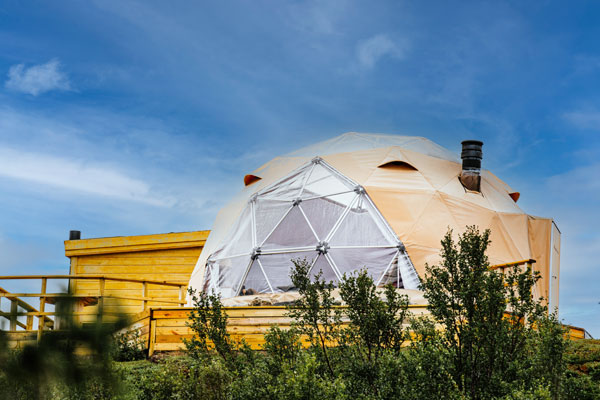
Dome House Frames

When building my own tiny home, I learned a lot about how to make sure the frame of your house is strong and supportive of your interior. The frame is the bones of your home and is extremely important in ensuring a sturdy build.
You have two main options when it comes to framing for your dome home: wood or metal. There are pros and cons to both, but while wood framing is convenient, you’re still going to need to use metal brackets to join them. Those brackets can cost quite a bit unless you’re particularly good at fabricating metal.
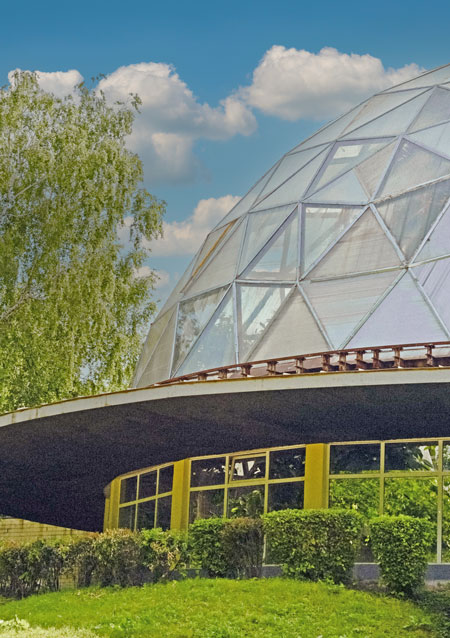 For this reason, I lean towards using all metal framework from a reputable manufacturer. Galvanized steel or another highly durable metal is the best way to go with geodesic dome homes because they hold the shape of the house and don’t allow outside factors to mess with it.
For this reason, I lean towards using all metal framework from a reputable manufacturer. Galvanized steel or another highly durable metal is the best way to go with geodesic dome homes because they hold the shape of the house and don’t allow outside factors to mess with it.
Powder coated beams are essential to increase the life of your framing. With powder coating, you can also change the color of your frame. I would probably paint my dome house a darker color to contrast with a lighter color cover, but the world is your oyster when it comes to choosing a color.
Another important thing to consider when choosing a dome frame if whether or not you want your dome house to be transportable. I know many families who build their geodesic houses with struts that can be disassembled. That way, if they want to take their dome house to the middle of a state park somewhere like a tent, they can!
However, there are perks to building your dome home with a permanent frame, too. Permanent geodesic houses are more resistant to bad weather and are easier and safer to live in. It all depends on what your personal dreams are for the space.
Geodesic Dome House Covers

Geodesic dome home covers are one of the most customizable features of a dome home. Like I said before, I’ve never actually built a dome home, but I love the idea of creating my dome home cover with glass that allows natural light to pour into the structure.
However, choosing a clear dome house cover definitely sacrifices privacy. I also love the idea of building a cover out of a smooth, maple-colored hardwood. There are so many options for geodome cover materials, and each comes with its own set of pros and cons.
pros and cons of each cover material type
| Cover Materials | Material Types | Advantages | Disadvantages |
|---|---|---|---|
| Wood | Plywood, hardwood, wooden shingles, oriented strand board, masonite | Durable, can withstand inclement weather, increased structure longevity | Permanent, impossible to transport, poor ventilation |
| Metal | Galvanized steel, metal cladding, aluminum panels | Durable, can withstand inclement weather, increased structure longevity | Makes dome home feel small / increased claustrophobia, cannot transport, poorest ventilation |
| Glass | Toughed glass, tempered glass, fiberglass, laminated glass, thermal glass | Best natural light | Clear walls limit privacy, mediocre ventilation and insulation |
| Plastic | Polyvinyl chloride, polyethylene plastic, ETFE foil | Can easily remove cover / transport structure, best insulation (especially for a greenhouse) | More easily torn or damaged due to weather, less durable |
| Fabric | Vinyl fabric, ripstop nylon, parachute silk, polyester | Can easily remove cover / transport structure, good insulation, great ventilation | More easily torn or damaged due to weather, less durable |
| Concrete | Shotcrete, gunite, airform concrete | Durable, weather resistant, increases structure longevity | Permanent, impossible to transport, poor ventilation |
| Foam | Expanded polyurethane | Quality insulation, protected from sun damage, weather resistant | Permanent, difficult to transport |
Dome Home Doors

When it comes to geodesic dome house doors, there are two basic structural options you can choose from: pre-hung doors and zip-doors. Pre-hung doors are what most homes use and can be picked up at virtually any hardware store.
If you’re going with a solid cover material, you’ll obviously have to go the pre-hung door route. However, contrary to common belief, if you go with a malleable cover material like fabric, plastic, or even fiberglass, you can also use a pre-hung door.
Zip-doors are the perfect option if you want your geodesic dome house to be fully mobile. They’re great for camping or off-gridding in your geodome.
Geodesic Dome Home Windows

- Round windows
- Bay windows
- Skylight windows
Round windows on a geodesic dome house are usually nestled into the exterior triangles on the dome house. They are commonly made of vinyl materials. Bay windows circle around the entire dome and are the better option if you want an entire wall of window. This lets in a lot of natural light, but won’t give you as much privacy as other options.
In many geodesic dome homes, skylights are an extremely popular option. Skylight windows typically range from 18 to 24 inches and are designed especially for sloped roofs.
Most geodesic dome houses integrate all three of these window types into one single dome house to let in as much natural light as possible!
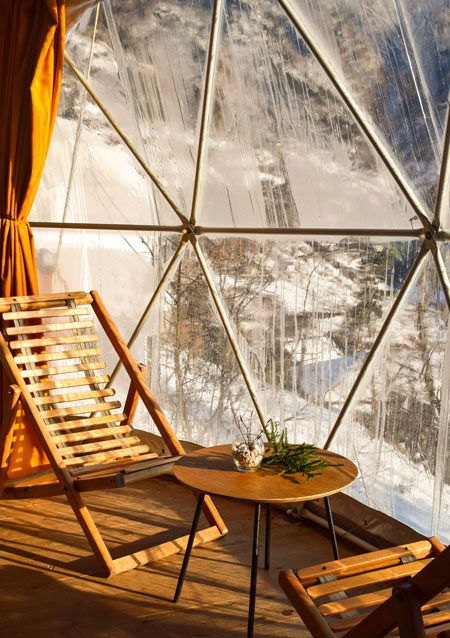
Geodesic Dome House Insulation

As far as insulation is concerned, the most common method for heating a geodesic dome house is by using a wooden stove. However, any modern heating method that works on a traditional dwelling can be manipulated to work as well.
Ways to heat a dome dwelling
- Wood stove
- Radiant heat
- Solar panels
- Propane
- Natural gas
- Electric
- Pellet Stove
- Thermal Mass Heater
- Hydronic
Having lived in my tiny house for seven winters now, I know a little bit about how to stay warm in a cold climate and trap heat where needed. The last thing you want to experience is being freezing cold inside your own home, especially if you live in a colder climate.
I have certainly come face to face with the challenges of heating a tiny house, and geodesic dome homes can be even harder to keep warm! Even if you choose a cover material which isn’t removeable, the general shape of a dome house makes it a lot more challenging to trap heat within the structure.
Some people use insulation liners inside their dome, which is a practical approach, but many people don’t like the look of them. The upshot here is that you can add them in just the winter if you need more insulation in a pinch.
Geodesic Dome House Plans

Creating the perfect dome house is all about the design. Depending on what you use your own geodesic dome house for, you’ll want to design it in a way that works for you and your lifestyle.
If I was building a dome house, I know I’d want room in the home for my book collection, as well as a little extra space for when my family comes to visit. There are a few popular dome homes designs and dimensions that stand out.
18’ Geodesic Dome Home Floorplan
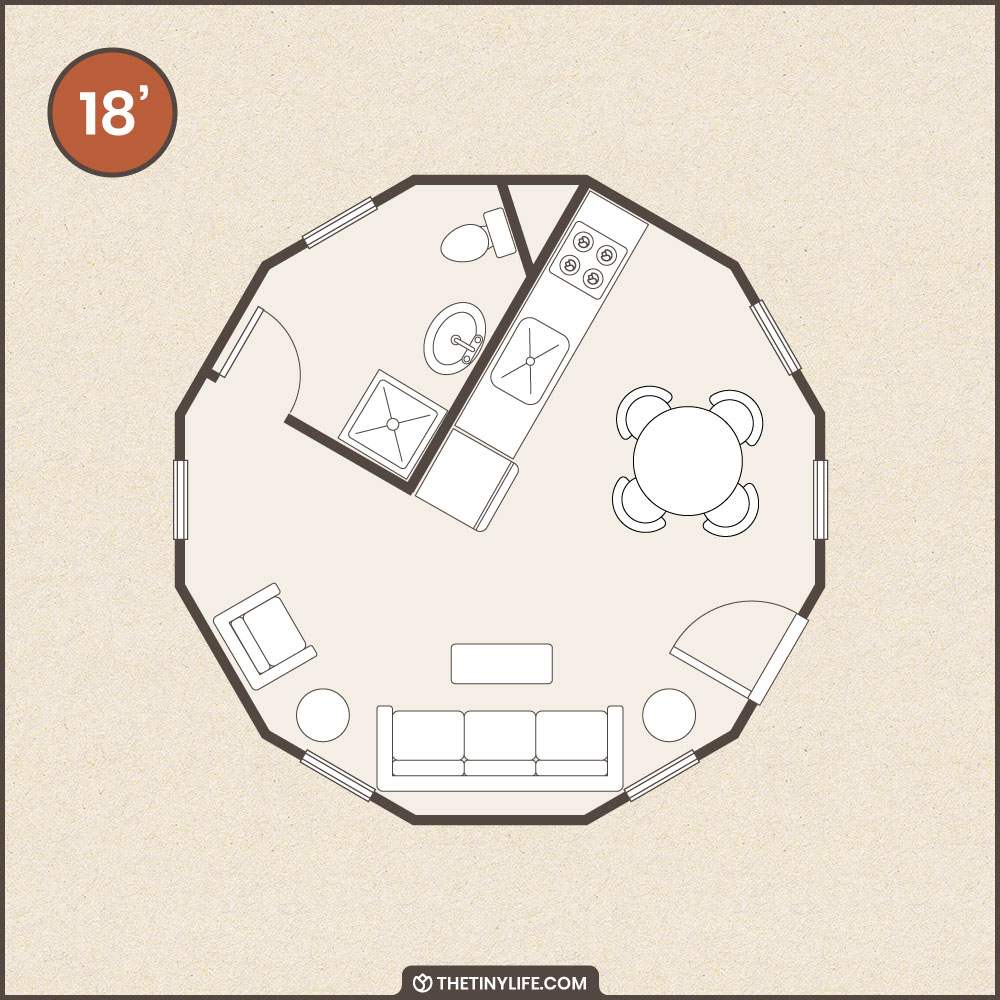
18 feet across is a common size for dome houses, but can feel a little small. This is a wise option for a floorplan if you’re looking to make your geodesic dome home into a studio or a small work space, but might be more challenging to use as a full-time home unless you’re already accustomed to the tiny life. This floorplan could also serve as a guesthouse or ADU with a fold-out sofabed.
24’ Dome House Floorplan
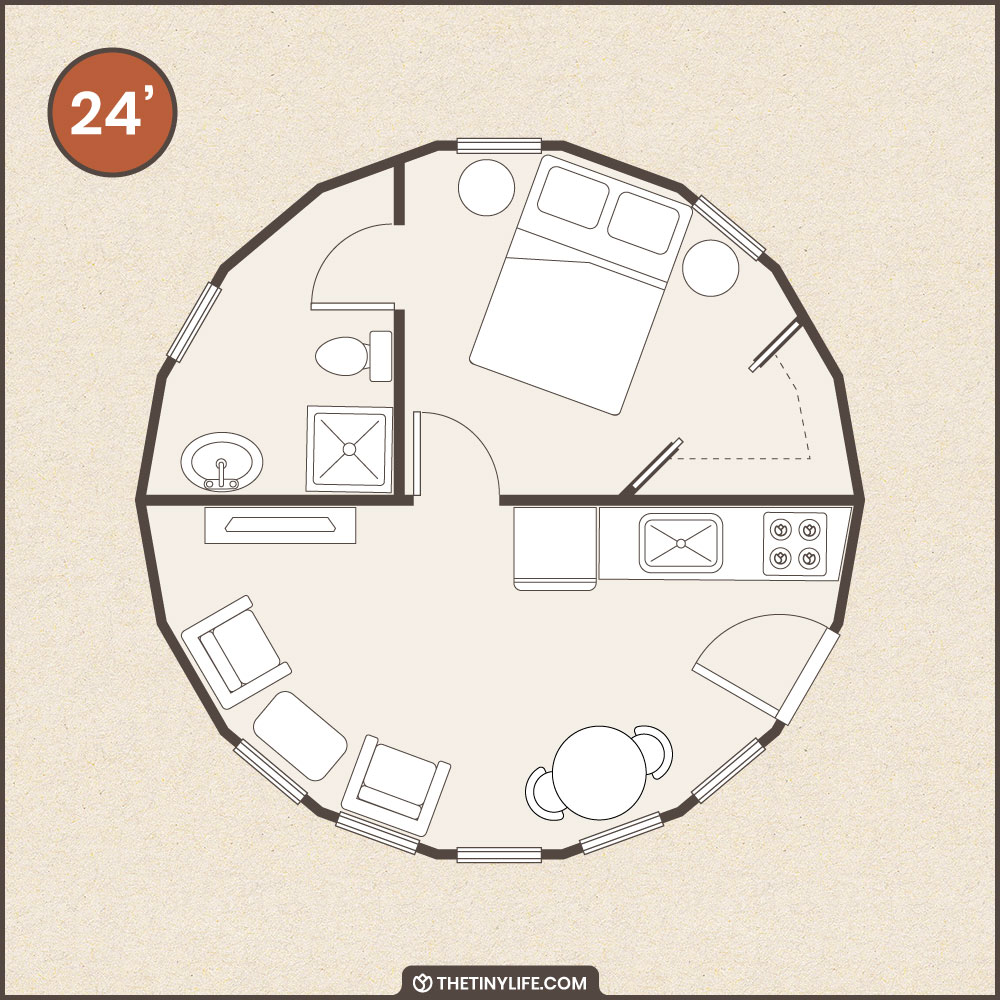
24’ is the ideal size dome house for 1-2 people while keeping the cost lower. This floorplan has room for one master bedroom. The main room could be used as a shared living room, kitchen, library, or anything else you may need! You can choose to connect your dome home as an accessory to your main home, or detach the geodesic house entirely.
Floorplan For 30’ Geodesic Dome
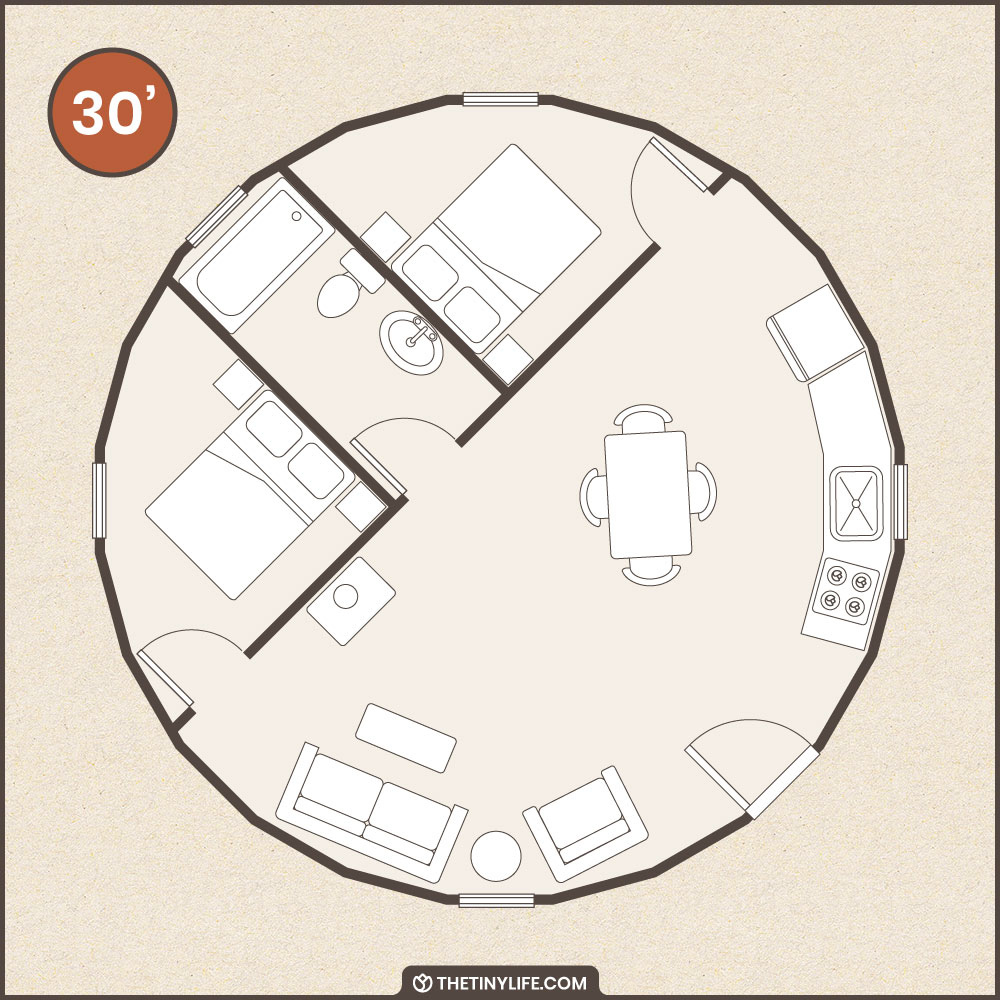
This 30-foot geodesic dome floorplan is outfitted with two master bedrooms, living room, dining area, bathroom, and possibly an additional story. This size of dome home is ideal for housing guests as well as your family full time.
36’ Geodesic Dome House Plan
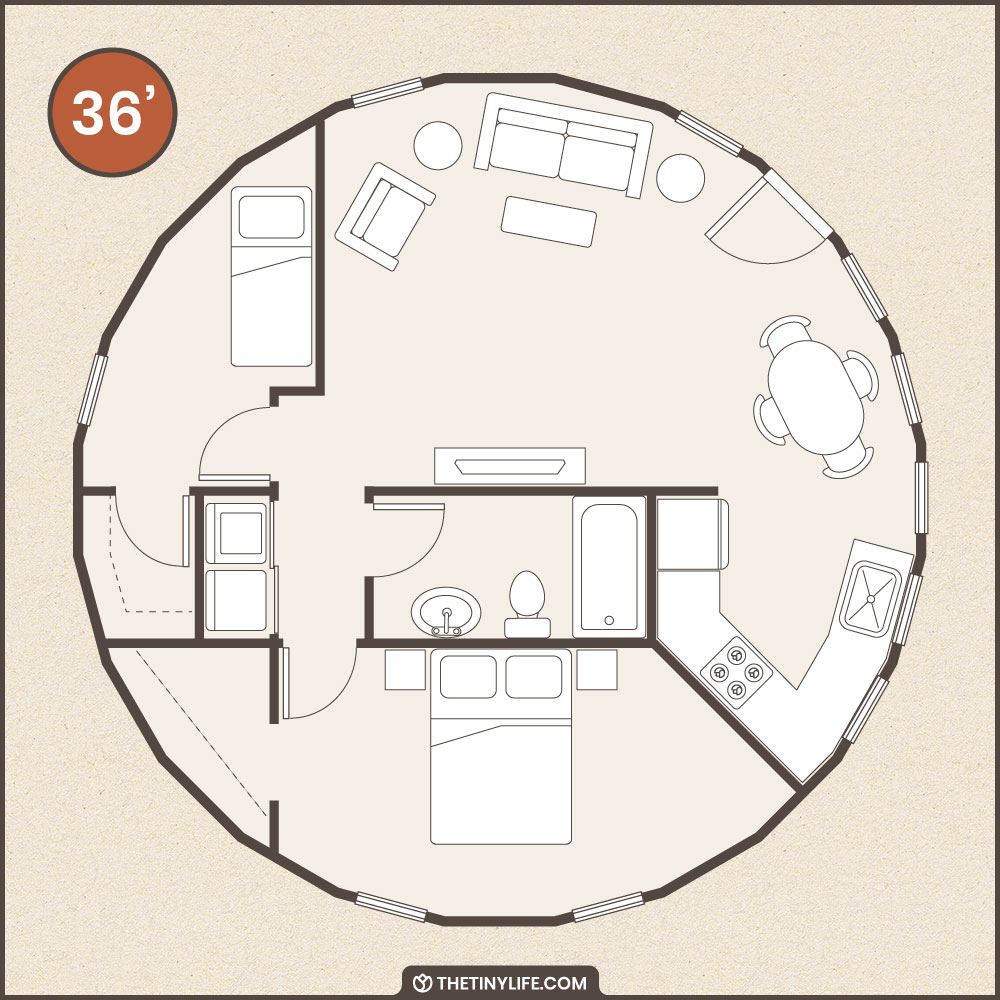
At 36 feet across, this floorplan works well for families. With two bedrooms, a laundry room, kitchen, and plenty of storage space. There’s room to pursue eco-living in your dome home full time.
42’ Geodesic Dome Home Plans
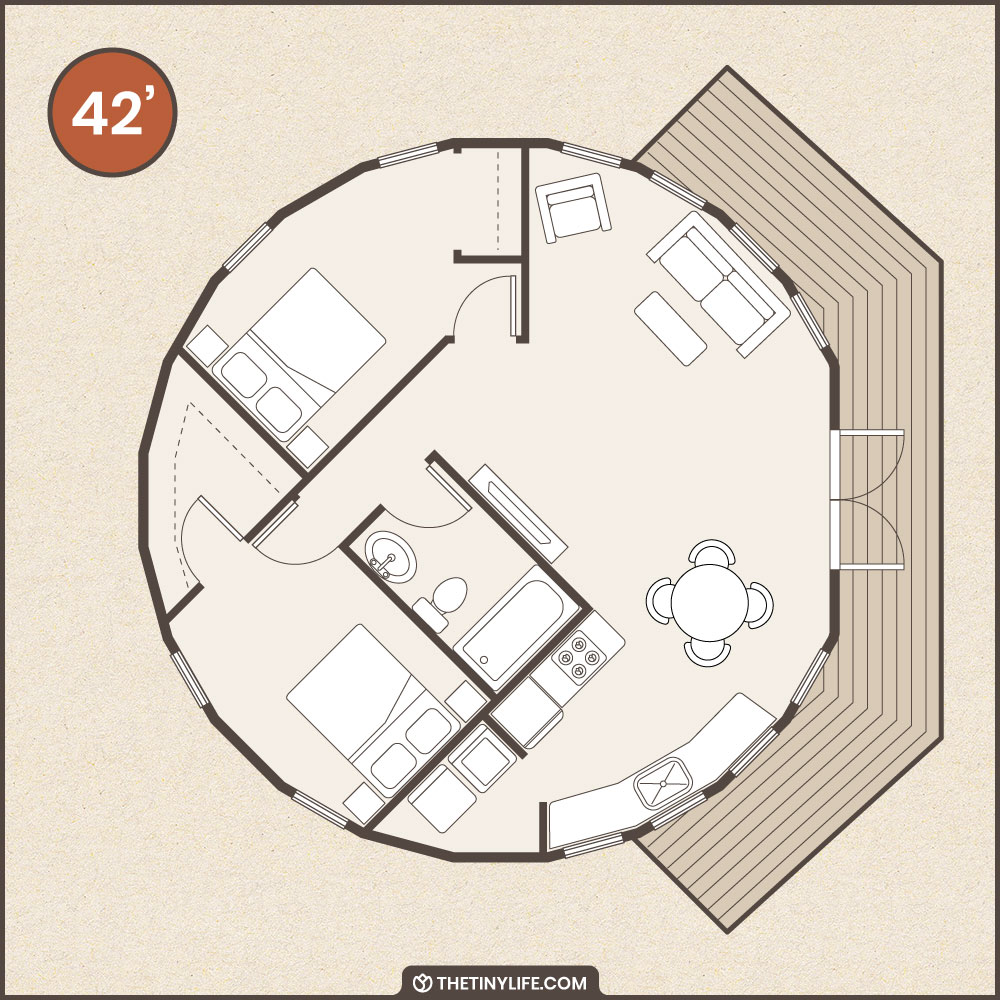
A 42-foot dome home will have more than enough room to live in full time, plus have extended family over to stay awhile! This floorplan has space for a dining area, second bedroom, kitchen with walk-in pantry and washer/dryer, full bathroom, and an entire second story could be added for more space.
Geodesic Dome Home Uses

Geodesic dome homeowners use their domes in vastly different ways. Living in a dome does not always mean making it your full-time house — there are many ways to enjoy your gorgeous structure.
Eco-Living In A Geodesic Dome

Living an eco-friendly life in a dome house is a wonderful way to feel close to the earth. The “one with the earth” approach to life is a little too hippy-esque for me, but I do love the idea of living a less-waste lifestyle to protect the earth that provides for us.
A huge aspect of living simply is being energy efficient, and geodesic dome homes are an awesome way to implement this into your daily life. While geodesic dome homes do present their challenges, like creating individual rooms or hanging things on walls, the energy efficiency, abundant natural life, and zany design can make them well worth it.
Geodesic Dome Glamping

Geodesic dome houses make awesome glamping Airbnbs, and are extremely popular to use for large groups. You can easily throw down several dome houses in a line with a fabric covering and use them as luxurious glamping spaces for your guests and loved ones.
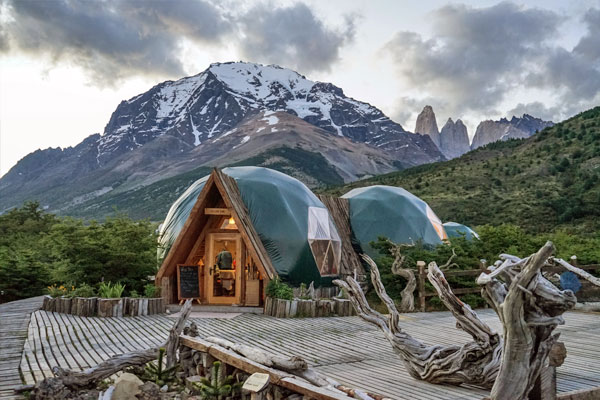
Using A Geodesic Dome As A Studio

Imagine being able to paint, draw, write, make music, or create anything your heart desires in a beautiful, eco-friendly space flooded with natural light. Studio spaces are an increasingly popular way that owners choose to use their geodesic spaces. It’s very common for domes to be integrated as an attachment to the main house and used as an art or yoga studio.
Geodesic Dome House As Emergency Shelter

Dome houses can also be used as emergency shelters for those in need. Due to the fact that they are easy and quick to assemble, geodesic dome homes make ideal encampments for those seeking refuge.
They are quicker and easier to build than traditional homes, and, if made with fabric or plastic covering and malleable struts, can easily be taken down and transported like a camping tent. This makes them perfect as makeshift shelters.
Geodesic Dome Emergency Shelter Examples
- Medical centers
- Classrooms
- Supplies distributions
- Warehouse
- Kitchen
- Refugee encampment
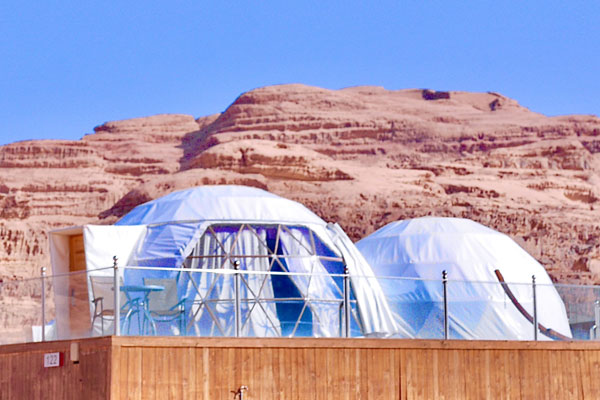
How Much Does A Geodesic Dome Home Cost?

If you were like me when I first started out in the alternative housing craze, I had one big question: How much will this project actually cost me? Dreams are one thing, but bringing your dreams to life is another, and it can make a bigger dent in your pocketbook than you think.
How do you make sure building a geodesic dome house will be worth the investment? It all depends on the direction you take. The cost of your dome home will greatly depend on whether or not you decide to build it on your own, purchase a dome house kit, or hire a builder to create your dream dome.
As a general rule, dome houses typically cost between $100 and $250 per square foot if you partner with a builder. This price includes finishing the home and labor costs, but does not include buying or preparing your land for the building process, which you should certainly not neglect in your budget.
On the other hand, you could build a tiny dome house as a permanent shelter for under $10,000 if you do it yourself and are extremely frugal with your material costs and design choices. The overall cost breakdown of your geodesic dome home will heavily depend on whether or not you choose to buy or build your dome.
Geodesic Dome Home: Build or Buy

My choice to build my tiny house myself was honestly one of the best choices I could have made. It gave me a real sense of purpose in life and control over my dream home, as well as that satisfying feeling of accomplishment once you have created something you’re truly proud of.
Dome houses can be a little more architecturally complex than tiny homes, though, so you want to make sure you’re prepared if you build it yourself. If you build your geodesic dome home yourself, you’re looking at a year of time dedicated to the project at the very minimum.
At the end of the day, there are many factors to consider when making the decision to buy or build. You’ll want to consider cost, freedom in design, turn-around time, your building skills, and whether you want to hire a builder.
DIY Geodesic Dome Kits

Kits are a pretty brilliant middle ground option between buying and building. They give you the joy of building your dream dome home on your own without forcing you to navigate every step of the way without guidance.
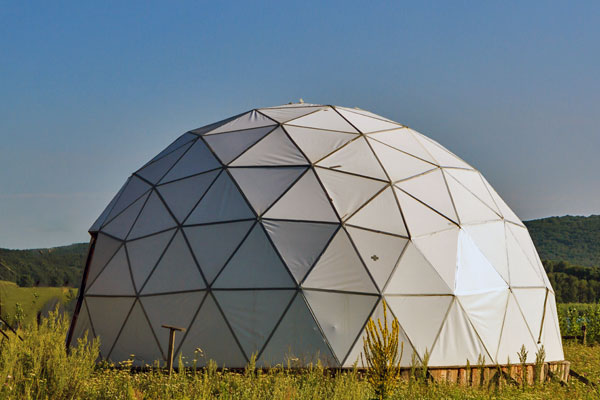 A dome house kit includes the bones of what you will need to build your dome house, but you provide the actual labor. Dome house kits are the easiest, cheapest, and quickest way to create a dome home that is ready for you to live in — score!
A dome house kit includes the bones of what you will need to build your dome house, but you provide the actual labor. Dome house kits are the easiest, cheapest, and quickest way to create a dome home that is ready for you to live in — score!
However, I’m honestly not a huge fan of kits because I like to have more of a say over each piece that goes into my home. If you don’t feel the need to be in total control of your own design, they are a great option for reducing labor, time, and decision fatigue.
You can purchase geodesic dome home kits from many different designers. The most popular geodesic dome home kit company is Timberline. Timberline offers a hub-and-strut framework which allows homeowners with little to no building experience to build a full-size dome house. Their kit includes everything you will need except socket wrenches, hammers, and a ladder.
Another company worth trying is Hypedome. Hypedome’s many different dome house kit styles can be assembled easily in your own yard. Design styles include clear, wooden, and mirrored dome homes.
You can purchase a geodesic dome home kit for as little as $200 for a playpen or small garden, and as much as $15,000 for a full-sized geodesic dome home.
Dome kits typically include
- Plywood triangles (if using wood covering)
- Canvas material (if using cloth covering)
- T-beam struts (base and side struts)
- Screws
- Stainless steel straps
- Basic how-to assemble instructions
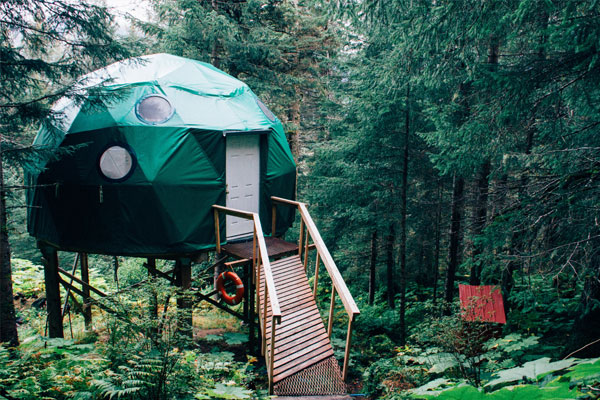
Geodesic dome homes can be a challenge to assemble. Most experts recommend having at least three or four friends with you when setting up your first dome house.
Additionally, it is important to note that most dome kits are built atop concrete foundation slabs that you will either have to hire someone to help you pour or pour on your own. The rest, however, you can assemble yourself using your own tools.
Assembling Dome House Frame With Geodesic Dome Kits
Each kit should come with its own specific set of instructions, but most of them will start the same way. Your kit will come with T-beam metal struts that you can use to assemble the frame of your geodesic dome house. When you assemble your struts, you will work from the outside in, getting closer and closer to the center of the dome house foundation.
Lay your base struts around the perimeter of row one, connecting them to one another at an acute angle and attaching them together with screws. Next, lay out row one of your side struts in a triangular shape on the inside of your base struts, and attach these with screws as well.
Finally, lay out the base of row two in the same way you laid out the base of row one, and attach your struts. You now have the first row of your dome house assembled and are ready to raise it to height. With the help of friends, stand up row one, and bolt the base of row two to row one.
Now, you should have the beginnings of a circular wall surrounding your foundation. Repeat this process until the frame of your dome has been assembled. Once complete, use stainless-steel ties to secure the nodes between each of the metal struts.
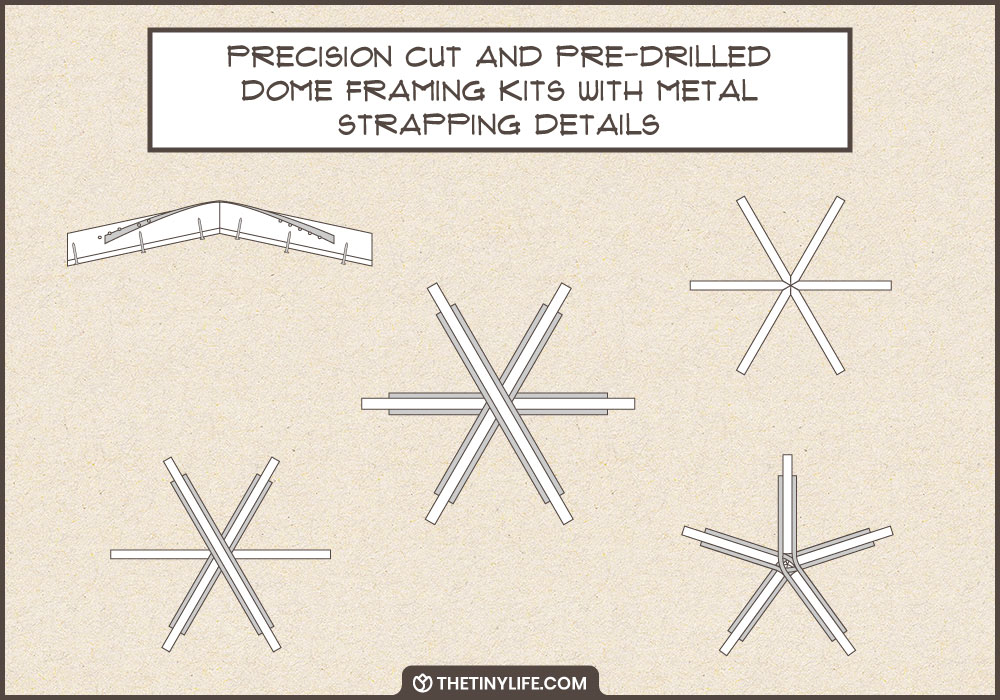
Assembling Dome House Cover With Geodesic Dome Kit
Some dome kits will include a cloth, plastic, or fabric covering. The process of attaching the covering will look like unraveling the mesh or canvas cover and tying it to the inside and outside of the struts with ties.
When attaching your cover to your geodesic dome house, pull your cover material upwards from the ground instead of rolling it out from the top of the structure. Be sure to tie your cover material to your frame as you go so it doesn’t fall off as you assemble it.
Other dome kits will include triangular plywood panels or shingles to use as the cover for your geodesic dome home. With these kits, make sure you attach each panel with screws and washers, surrounding the entire structure.
How To Build A DIY Geodesic Dome Home

If you’re feeling like the ultimate do-it-yourselfer, you can undergo the process of building your own geodesic dome house without buying a geodesic dome house kit to assemble. Kits are definitely the easier route, but it doesn’t mean it’s the only way to go!
Going the DIY route, you’re looking at cutting a lot of material, buying a lot of individual pieces, doing lots of additional labor, and doing a lot of math all on your own. It’s hard work, but can be well worth it.
The main advantage to building your dome house on your own is that you have a lot more freedom to edit the design and layout of your dome home so it turns out exactly how you want it to instead of the way the kit company designed it. When I built my own tiny house from scratch, I loved that I had control over each element of my home.
How to build a geodesic dome house with no kit
- Cut metal struts to your needed size
- Cut geodesic covering from choice material
- Pour the concrete slab
- Use wooden beams to raise base, if desired
- Build out your wooden deck
- Attach metal struts to deck with screws
- Use stainless steel ties to secure nodes
- Attach cover to metal struts
- Paint inside of geodesic dome house
- Paint outside of geodesic dome house
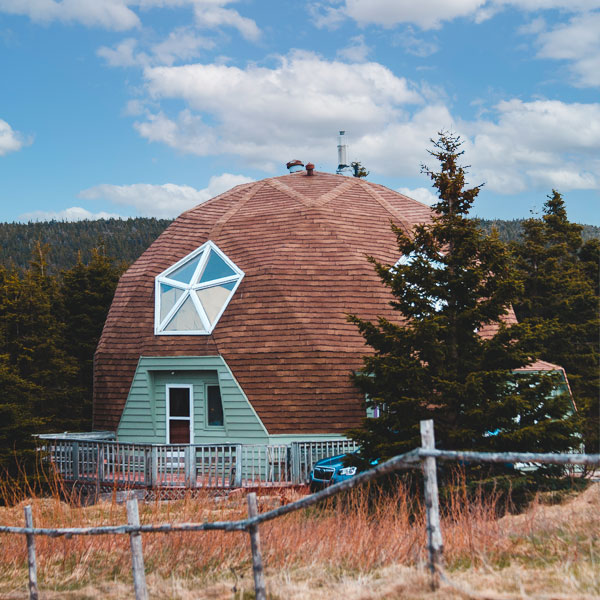
Geodesic Dome Home Builders

Of course, there is nothing wrong with buying your geodesic dome house from a design and build company. The geodesic dome homes that building companies create are gorgeous, and save you a lot of hard work and room for error.
You don’t have to go through the tedious process on your own if you don’t want to — that’s what awesome building companies are here for!
Geodesic dome house builders to try:
When I think about everything that a dome house could add to my life, I definitely wonder if it’s the next tiny structure I’ll build. I imagine myself inside a dome structure, surrounded by books and nature, totally at peace.
Your Turn!
- How will you design your geodesic dome home?
- What purpose would a geodesic dome serve in your life?





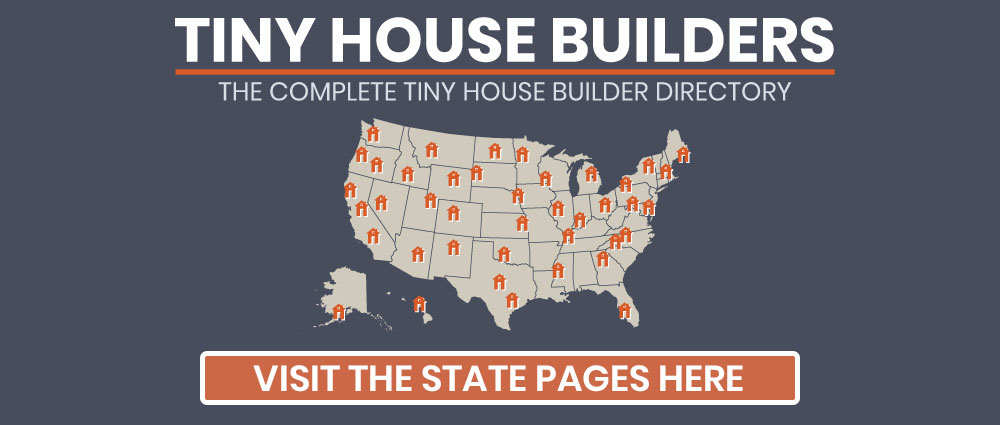
I would like to know what the 36′ dome cost and how can I get help putting it in and built?
What would be the best dome home material for a house in Florida? And how do you add dormers to one?
THANKS!!
Tell me more plz
I am still going to buy a geodesic dome home. I am not going to let anybody tell be the cons or drawbacks.
The people that bring the kit can install it with rooms
And possibly make it leak proof. The cons are just your opinions. I am not going to listen to them.
I hate the house I am in now, a lot .
A geodesic dome home I feel is a lot better than the
House I am in now.